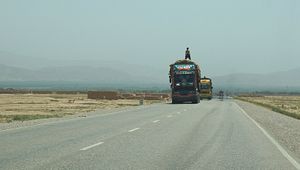Driving along Afghanistan’s roads is not like driving anywhere else in Asia. Traffic can stand still for hours, an engine can give out on ascent of a mountain in a remote village, and in wayward towns in Wardak Province, some drivers have found themselves engulfed in IED craters large enough to swallow an entire 18-wheeler.
It’s not an exaggeration to say that Afghanistan’s roads are in astonishingly meager condition. The Washington Post recently observed that the government is unable to maintain most of the roads constructed since American troops entered the country in 2001.
That problem will be at the forefront of Afghan President Ashraf Ghani’s ambitious agenda when he arrives at the White House on Tuesday. Ghani hopes to secure long-term economic assistance, crucial to establishing Afghanistan as a trade hub at the heart of Central Asia. Before this vision can materialize, Afghan merchants need roads to transport their goods to market.
No place better exemplifies the problems facing Ghani’s vision than the proposed Gardez-Khost Highway, a 101-kilometer road which would effectively link Kabul, eastern Afghanistan, and Pakistan. Since it was conceived, the project has been mired in disaster.
Initial plans for Gardez-Khost called for the construction of a national highway system, similar to the American interstates. The United States Agency for International Development (USAID) was tasked with constructing a flagship road within reasonable distance of two-thirds of Afghanistan’s population. This flagship road is known today as the “Ring Road” or “Highway One.” Beyond the “Ring Road,” national highways link the vast network of provinces to Kabul. Branching out from those are tertiary roads which draw in remote tribal regions.
The U.S. and its NATO allies recognized the necessity of well built and maintained roads to securing Afghanistan, spending nearly $4 billion in construction and maintenance costs over the course of more than a decade of war. Despite these enormous outlays, last year, the World Bank found that 85 percent of Afghani roads remain in “poor condition.”
The completed Gardez-Khost Highway would help. It will be 101 kilometers long, linking Kabul and eastern Afghanistan with the Ghulam Khan Highway in Pakistan. The project has a sunk cost of around $320 million dollars, much of which has fallen into the hands of tribal leaders with ties to the Taliban.
The road has been under construction since 2003. USAID projects it will be finished by December, with costs totaling nearly $5 million per mile. That factors in the expensive task of securing the road: working crews alone cost $700 thousand per mile. It’s also been a battle of political will to keep the project on track. Within the lifetime of this project the United States has neglected, refocused, and subsequently withdrawn from Afghanistan.
The U.S. plans on spending a small amount for road maintenance in the future. That’s a problem: without American support, security, and funding, Mohammad Aref Raiskhel, director of maintenance for Afghanistan’s Ministry of Public Works, claims that further maintenance on these roads will be next to impossible. Road maintenance in Afghanistan is not as simple as sending out a road crew. In the worst years of America’s campaign, the army would have to dispatch an entire platoon to keep road workers safe from insurgents. In 2014 alone, Afghan Security forces unearthed nearly 200 IEDS on “Ring Road.” Six months ago, World Bank inspectors were forced to curtail their inspection after being immediately targeted by local Taliban.
The battle to maintain Afghanistan’s roads is a test of Ghani’s ability to govern. The Taliban and other Afghan insurgents have a vested interest in reclaiming transportation networks within the tribal provinces. Ghani’s visit to Washington is motivated by his inability to exert influence beyond the city of Kabul, further hampered by funding and corruption issues.
When the Gardez-Khost highway is completed, in December, vast sums of money will have changed hands, hundreds of lives will have been lost, and an entire war will be moving toward conclusion. Can Afghanistan’s government maintain the road? To support the villages most vulnerable to the Taliban, Ghani and his administration must do everything they can.
Saagar Enjeti is a policy and data analyst in New York City.
Correction: This article previously claimed that the United States had no plans to fund Afghan road maintenance. USAID is funding multiple road maintenance and related projects in Afghanistan through at least 2017, with around $30 million in earmarked funds.

































